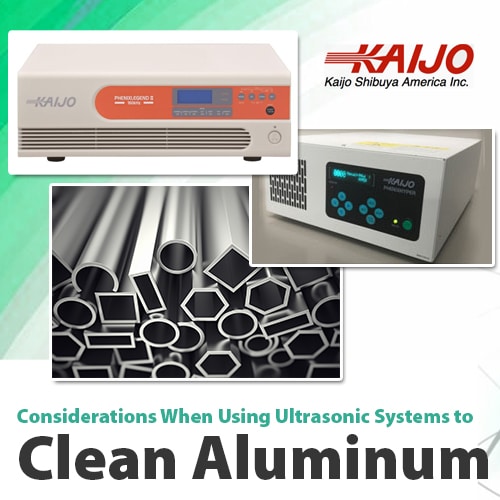Considerations When Using Ultrasonic Systems to Clean Aluminum
April 7, 2022
 Since most metal parts have hard surfaces, they can be cleaned using low ultrasonic frequencies that deliver powerful cleaning action. When faster cleaning is required, the cleaning solution can be heated and mild solvents can be added to speed up the cleaning process. The surfaces of parts made from aluminum are softer and need gentler cleaning. If a solvent is used to speed up cleaning, the highly reactive aluminum may react with the solvent in a chemical reaction that can produce byproducts and damage the parts. As a result, using ultrasonic cleaning systems to clean aluminum parts presents unique difficulties not present for parts made from other metals. Cleaning aluminum parts with ultrasonic cleaners can be effective, but it requires special considerations.
Since most metal parts have hard surfaces, they can be cleaned using low ultrasonic frequencies that deliver powerful cleaning action. When faster cleaning is required, the cleaning solution can be heated and mild solvents can be added to speed up the cleaning process. The surfaces of parts made from aluminum are softer and need gentler cleaning. If a solvent is used to speed up cleaning, the highly reactive aluminum may react with the solvent in a chemical reaction that can produce byproducts and damage the parts. As a result, using ultrasonic cleaning systems to clean aluminum parts presents unique difficulties not present for parts made from other metals. Cleaning aluminum parts with ultrasonic cleaners can be effective, but it requires special considerations.
Ultrasonic Cleaning of Aluminum Requires Higher Frequencies
Ultrasonic systems clean by generating microscopic cavitation bubbles in the cleaning solution. When the bubbles burst, they produce powerful jets of liquid that dislodge contaminants from part surfaces. The low frequencies of around 20 kHz used for parts made of hard metals such as stainless steel or cast iron generate comparatively large bubbles. The bubbles produce jets that clean the hard metal surfaces quickly without damage but which are powerful enough to damage soft metal surfaces such as those made from aluminum.
Because aluminum is relatively soft compared to other metals, the powerful jets of low-frequency bubbles can create pits on the aluminum surface and can damage delicate aluminum structures. Higher frequencies, above 38 kHz, produce smaller bubbles and less energetic jets of cleaning solution. The gentle cleaning action is safe for aluminum surfaces and pitting is avoided. For especially fragile parts with aluminum structures even higher frequencies may be needed to avoid damage. An experienced manufacturer of industrial ultrasonic cleaning systems can recommend the right frequencies and system configuration needed for a specific cleaning application.
Improving Ultrasonic Cleaning for Aluminum Parts
Using ultrasonic cleaners for aluminum parts delivers the same complete cleaning as for metal parts with hard surfaces. Contaminants are removed completely wherever the cleaning solution can penetrate, even in threaded holes, crevices, along seams, and around hinges. The main difference is that the cleaning intensity is lower with the higher frequencies and cleaning may take longer.
When fast cleaning is important for an ultrasonic cleaning application, the cleaning solution can be heated and a mild detergent or solvent can be added to the ultrasonic cleaning tank. Heating softens oily or greasy deposits and makes them easier to remove. Detergents and solvents can be chosen for specific contaminants and dissolve the bonds that hold the contaminating substance on the part surface. The contaminant is then dislodged by the ultrasonic bubbles and rinsed away.
Aluminum parts are not affected by the temperatures in the ultrasonic cleaning tanks, so heating the cleaning solution will speed up the aluminum cleaning process. When adding solvents, special consideration has to be given to the high aluminum chemical reactivity. Aluminum reacts with both acidic and basic solutions and the chemical reactions may damage the parts and release unwanted byproducts. If a solvent or detergent is used for cleaning aluminum, it has to be chemically neutral. A neutral detergent often works best for speeding up ultrasonic cleaning of aluminum parts in a heated solution.
Kaijo Helps Customers Select the Right Ultrasonic Cleaner for Their Application
Selecting the right ultrasonic cleaning systems for cleaning applications depends on many factors, including frequency, power, heating capability, and the right solvent or detergent. Kaijo provides expert guidance to customers to ensure they use the right ultrasonic system for their specific cleaning application. With Kaijo’s help, customers can be sure that all of their aluminum parts and other components are safely and effectively cleaned using the latest ultrasonic cleaning technology. Contact Kaijo for a free consultation to discuss your specific cleaning application.





